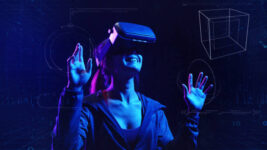
The Future of Wearable Technology
Introduction: Wearable technology has come a long way since the introduction of the humble pedometer. From smartwatches and fitness trackers to augmented reality glasses and biometric sensors, wearable devices have become an integral part of our daily lives, revolutionizing how we interact with technology and augmenting our capabilities in various domains. In this in-depth exploration, we’ll delve into the exciting realm of wearable technology and envision the possibilities that lie ahead as we embark on a journey towards a more connected, intelligent, and personalized future.
Section 1: The Evolution of Wearable Devices 1.1 From Pedometers to Smartwatches:
- Trace the evolution of wearable technology from early fitness tracking devices to modern smartwatches capable of performing a wide range of functions, including notifications, fitness tracking, and mobile payments. 1.2 Expansion into Health and Wellness:
- Explore the role of wearable devices in promoting health and wellness, including advancements in heart rate monitoring, sleep tracking, stress management, and activity recognition.
Section 2: Augmented Reality and Smart Glasses 2.1 Introduction to Augmented Reality (AR):
- Define augmented reality and its potential applications in wearable technology, including overlaying digital information onto the physical world to enhance user experiences. 2.2 Rise of Smart Glasses:
- Examine the emergence of smart glasses, such as Google Glass and Microsoft HoloLens, and their potential to revolutionize industries like healthcare, manufacturing, education, and retail.
Section 3: Fitness Trackers and Biometric Sensors 3.1 Tracking Physical Activity:
- Discuss the role of fitness trackers in monitoring physical activity, including steps taken, calories burned, distance traveled, and active minutes. 3.2 Biometric Sensors for Health Monitoring:
- Explore the integration of biometric sensors into wearable devices for real-time health monitoring, including heart rate, blood pressure, blood oxygen levels, and electrocardiogram (ECG) measurements.
Section 4: Wearable Technology in Healthcare 4.1 Remote Patient Monitoring:
- Highlight the potential of wearable technology for remote patient monitoring, allowing healthcare professionals to track vital signs, detect anomalies, and provide timely interventions. 4.2 Improving Patient Outcomes:
- Discuss how wearable devices can empower patients to take control of their health, improve medication adherence, manage chronic conditions, and enhance overall well-being.
Section 5: Future Trends and Innovations 5.1 Seamless Integration with Everyday Life:
- Envision a future where wearable technology seamlessly integrates into our everyday lives, becoming indistinguishable from traditional accessories while offering enhanced functionality and connectivity. 5.2 Advancements in Material Science:
- Explore advancements in material science and flexible electronics, paving the way for wearable devices that are lightweight, durable, and comfortable to wear for extended periods. 5.3 Personalized User Experiences:
- Discuss the importance of personalized user experiences in wearable technology, driven by artificial intelligence (AI) algorithms and machine learning models that analyze user data to deliver tailored recommendations and insights.
Section 6: Ethical and Privacy Considerations 6.1 Data Security and Privacy:
- Address concerns surrounding data security and privacy in wearable technology, including the collection, storage, and sharing of sensitive personal information. 6.2 Ethical Use of Biometric Data:
- Discuss ethical considerations related to the use of biometric data in wearable devices, including informed consent, data ownership, and protection against misuse or exploitation.
Conclusion: The future of wearable technology holds boundless potential to transform our lives in ways we have yet to imagine fully. As we continue to push the boundaries of innovation and explore new frontiers in connectivity, intelligence, and personalization, wearable devices will play an increasingly prominent role in shaping the way we live, work, and interact with the world around us. By embracing emerging trends, addressing ethical concerns, and fostering collaboration across disciplines, we can unlock the full potential of wearable technology and create a future where innovation serves to enhance the human experience.






